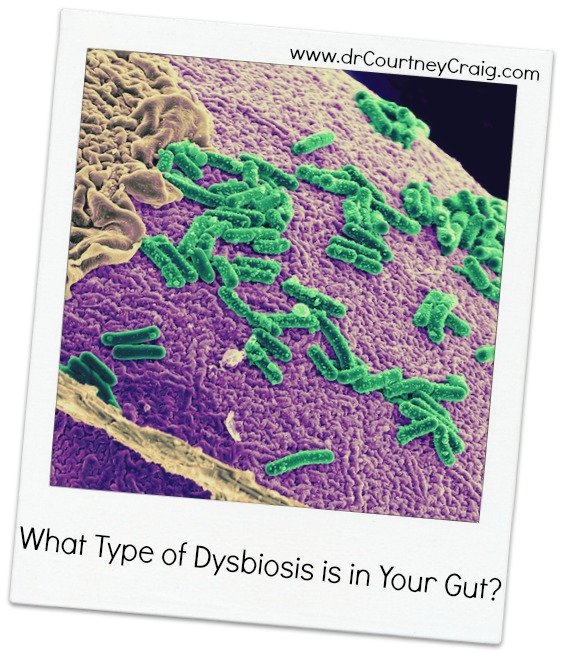What Type of Dysbiosis is in Your Gut?
Dysbiosis is the term used to describe an unbalanced relationship between the host (us) and microorganisms. Dysbiosis is common in the gastrointestinal tract but also may present itself on the skin, urogenital tract, sinuses, and oral cavity.
Did you think there was one kind of dysbiosis? There is more to dysbiosis than a simple imbalance of species. Here I present 4 subtypes of dysbiosis that have direct, indirect, and complex effects on the host--you!
Insufficiency Dysbiosis
Insufficient populations of “good bacteria” such as bifidobacteria and lactobacillus leave the gastrointestinal tract vulnerable to colonization with pathogens. Beneficial species in the gut help maintain the immune response in the gut, and promote digestion, elimination, and absorption. This type of dysbiosis frequently occurs after antibiotic therapy.
What to do?
Repopulate the gut with “good” species by choosing a quality probiotic and/or prebiotic supplement. Also support the growth of these beneficial species by consuming fermented foods and fermentable carbohydrates.
Bacterial Overgrowth
Excessive quantities of bacteria or yeast species in the gut can overcrowd beneficial species. Overgrowth of the small bowel is commonly seen in fibromyalgia, but also in immunosuppressed individuals and those on antacids. Bacterial overgrowth can cause various systems including gas and bloating, irritable bowel, constipation, sugar cravings, as well as muscle pain.
What to do?
Natural antimicrobials are effective at eliminating bacterial overgrowth in the small bowel. Natural herbs and oils put head-to-head against antibiotics were shown to be more effective. Oil of oregano, berberine, thyme, peppermint, artemisia, and others are safe and effective. Read more here.
Immunosuppressive Dysbiosis
Some microbes produce toxins that can suppress the immune system. For example, some microbes produce a protein-digesting enzyme called proteinase, which suppresses the main defenses in the gut: secretory IgA (sIgA). Proteinases not only destroy important mucosal antibodies in the gut, but can also break down tissues like collagen and keratin that can weaken the integrity of the gut lining—promoting “leakiness.” If overpopulation of the yeast candida albicans is present, an immunotoxin known as gliotoxin is released from these organisms which is known to also suppress the immune system.
What to do?
Eliminate unwanted microbes using natural antimicrobials mentioned above. Then restore healthy gut immune function by building up the mucosal lining with L-glutamine; the intestinal cell’s preferred substrate. Also consider supplemental lactoferrin and colostrum which are effective at boosting sIgA levels.
Allergic Dysbiosis
Some have an exaggerated response to otherwise beneficial yeasts and bacterial species in the gut. A hypersensitivity occurs in these patients leading to an inflammatory response. Symptoms may be more severe in this case with colitis, eczema, or atopic dermatitis.
What to do?
It is essential to eradicate even “normal” yeast or bacterial species to alleviate the hypersensitive reaction. This is best done by prescription interventions under the supervision of a healthcare provider. Repopulating with “good” species will be necessary to restore the gut environment but comprehensive stool testing will be required to ensure the right species are reintroduced.
References
1 Chedid V., et al (2014) Herbal therapy is equivalent to rifaximin for the treatment of small intestinal bacterial overgrowth. Glob Adv Health Med. 3(3):16-24. http://www.ncbi.nlm.nih.gov/pubmed/24891990
2 Vasquez, A. (2014) Dysbiosis in Human Disease: Pathogenic and Therapeutic Considerations in Diseases of Sustained Inflammation. CreateSpace Independent Publishing Platform.
3 Douglas LJ. (1988) Candida proteinases and candidosis. Crit Rev Biotechnol. 8(2):121-9. http://www.ncbi.nlm.nih.gov/pubmed/3067860
4 Shah DT, Jackman S, Engle J, Larsen B. (1998) Effect of gliotoxin on human polymorphonuclear neutrophils. Infect Dis Obstet Gynecol. 6(4):168-75. http://www.ncbi.nlm.nih.gov/pubmed/9812249
